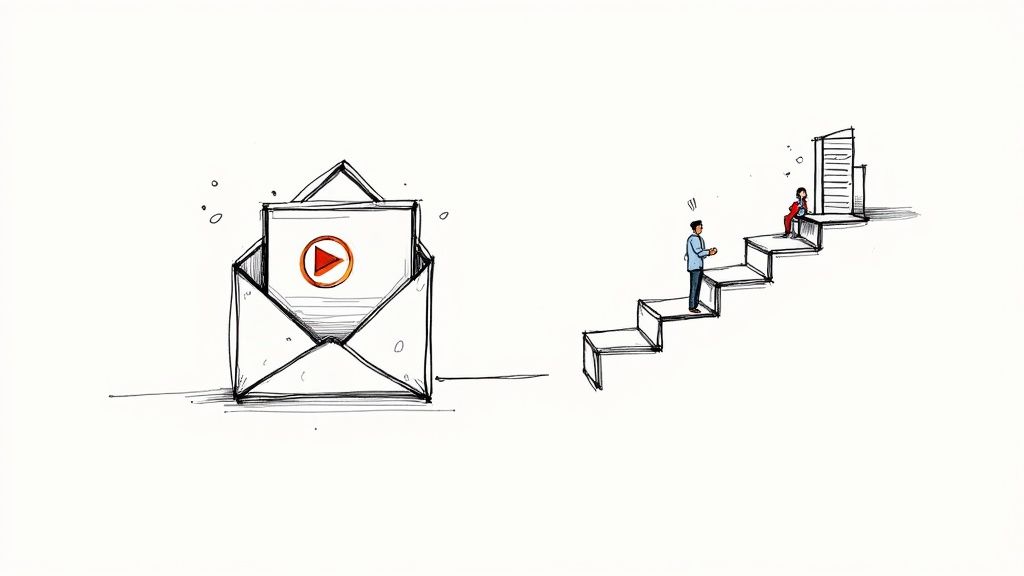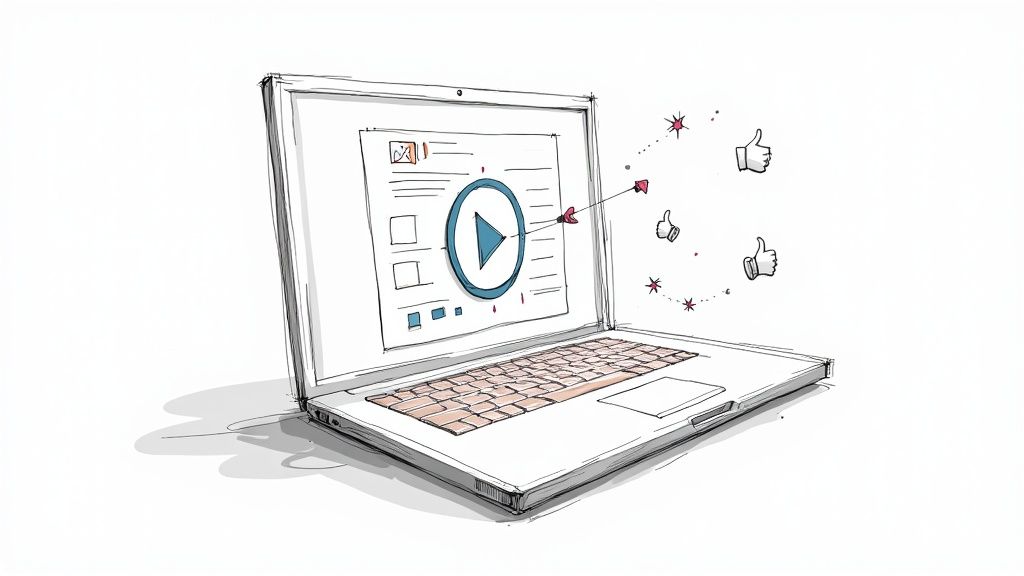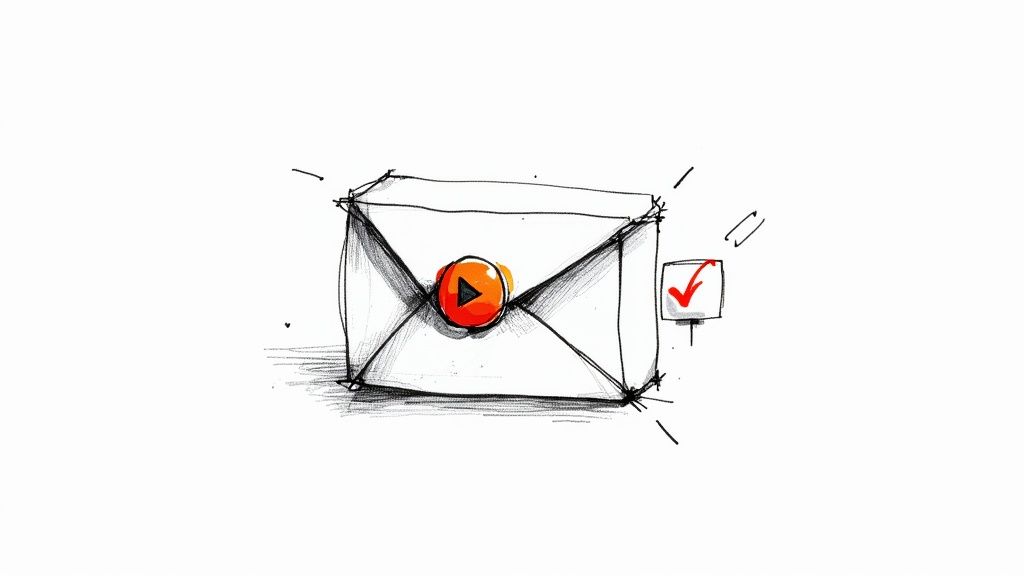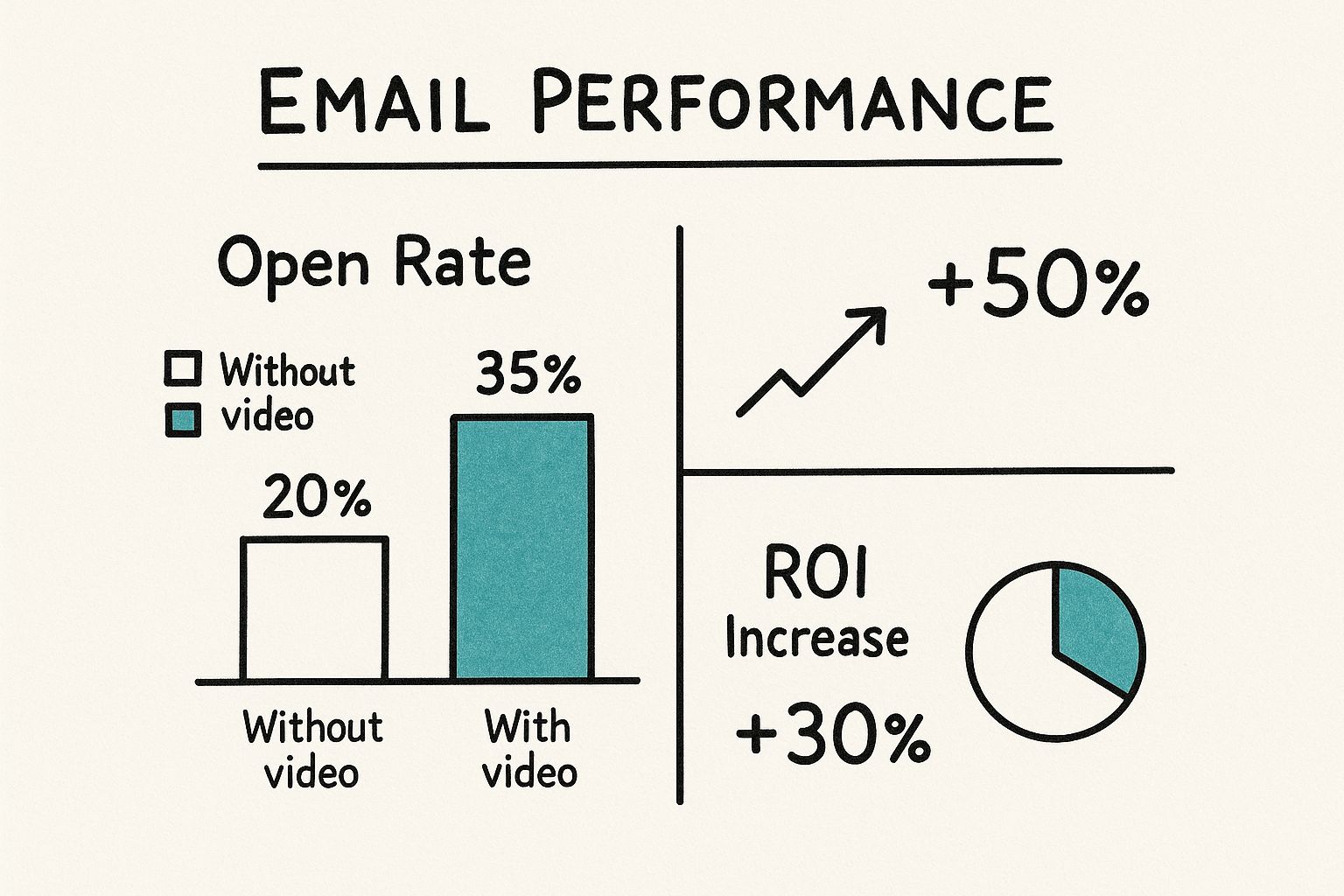
Video Email Marketing for Corporate Training Success
Let's be honest: traditional corporate training can be a real drag. We've all been there—staring at dense manuals or scrolling through text-heavy emails, feeling completely disengaged. In today's world, that old-school approach just doesn't cut it, leading to dismal completion rates and knowledge that goes in one ear and out the other.
This is where video email marketing comes in. It's not just a minor tweak; it's a strategic shift that turns employee development from a passive chore into an engaging, measurable experience.
Rethinking Corporate Training in the Digital Age

Think about the last training manual you were handed. Was it a multi-page beast that felt more like required reading for a final exam than a genuine learning opportunity? That’s the reality for most employees. The big challenge for Learning and Development (L&D) pros isn't just creating the content—it's getting it to stick.
And that's the magic of using video in your training emails. It’s a fundamental change in how companies can approach training and development. You're essentially swapping out that boring textbook for a personal, dynamic coach who shows up right in your employee's inbox.
Moving Beyond Static Content
The limits of old-school training methods are pretty clear. They’re one-size-fits-all, they don't really account for different learning styles, and there’s no good way to know if anyone is actually getting it. It’s a passive system that can leave major gaps in skills and company knowledge.
The answer is to make learning more dynamic and easy to access. As we rethink training, tools like a free video meeting distance learning platform are becoming crucial for flexible education. Video email takes this a step further by pushing perfectly timed, bite-sized training content straight to the learner.
By embedding video directly into email communications, L&D teams can create a continuous learning environment that feels less like a requirement and more like a resource. This strategy meets employees where they are—their inbox—and delivers content in the format they prefer.
A New Model for Employee Development
This approach directly tackles the real-world headaches L&D professionals deal with every day. Instead of just crossing your fingers and hoping employees do their training, you can guide them through a structured, engaging journey that actually works.
Here’s a look at how this new model plays out:
- Onboarding Programs: Ditch the boring paperwork. Send welcome videos from leadership or quick departmental intros to make new hires feel like part of the team from day one.
- Continuous Learning: Keep skills sharp by sending out weekly micro-learning tips or video summaries of recent workshops. It’s all about reinforcing key concepts.
- Skills Development: Need to teach a complex process or a new software? Deliver clear video demos that employees can watch, pause, and re-watch whenever they need to.
When you adopt video email marketing, you're doing more than just sending emails with videos. You're building a more resilient, skilled, and connected workforce, one video at a time. It transforms training from a one-off event into an ongoing, impactful conversation.
Why Video Email Is a Game-Changer for Learning

Let's be honest: traditional training materials often fall flat. Long, text-heavy emails and dense PDFs just don't hold our attention anymore. But dropping a video into those same training emails? That’s not just an upgrade; it’s a complete shift in how we approach learning and, ultimately, how our business performs.
Video grabs attention instantly and makes complex topics easy to follow. It’s about communicating with modern employees in the format they already prefer and use every single day.
By hitting both visual and auditory learning channels, video drastically improves how much information people actually remember. Imagine trying to explain a complex software workflow using only text. Now, picture a quick screen-recorded walkthrough instead. The video is clearer, leaves no room for misinterpretation, and lets people learn at their own pace, re-watching tricky parts as needed.
Boosting Completion and Connection
Getting employees to complete mandatory compliance or safety training is a constant headache for L&D teams. Those dry modules are just too easy to skim or ignore. Swapping that text for an engaging video turns a chore into a more dynamic experience, which is proven to lift completion rates.
But it’s not just about ticking boxes. In a world of remote and hybrid work, video builds a human connection that text just can't replicate. A welcome message from the CEO for new hires or a project update from a team lead feels so much more personal and genuine. It’s that human touch that helps build a stronger, more connected company culture, no matter where your team is.
The real power of video email marketing is its ability to turn passive information consumption into an active learning experience. It transforms a standard internal memo into a direct, engaging, and memorable training moment.
This jump in engagement shows up in the data. By 2025, emails that include video are on track to get a 22% higher open rate and a massive 100.95% higher click-through rate. Even better, they can slash unsubscribe rates by up to 75%, making sure your most important training updates actually get seen.
Driving Real Business Outcomes
The payoff from better training goes way beyond engagement stats—it hits the bottom line. When your team learns faster and remembers more, they become productive sooner and do their jobs with more confidence.
Think about the direct business impact:
- Faster Onboarding: New hires get up to speed in record time with clear video guides. This shortens their time-to-productivity and takes a load off their managers.
- Better Employee Performance: Quick, micro-learning videos sent by email keep skills sharp. This means fewer mistakes and higher-quality work across the board.
- A Stronger Learning Culture: When training is easy to access and genuinely interesting, people are more likely to seek it out. This builds a culture of continuous growth.
- Lower Training Costs: A single training video can be used over and over, providing consistent learning for hundreds of employees without the cost of repeated in-person workshops.
Of course, learning and development is a broad field. Exploring concepts like the role of keynote speakers in educational conferences can provide a wider view of effective teaching strategies. But by weaving dynamic content like video directly into your emails, you're not just sending communications—you're investing in your people.
Tools like Mindstamp take this even further by allowing you to create engaging, interactive learning content. You can add questions, quizzes, and clickable branching paths right inside the video, turning a simple viewing into a real, measurable learning assessment.
Putting Video Email to Work in Your Training Programs

Knowing the benefits of video email is great, but putting it into practice is where the magic really happens. Let's move beyond the theory and look at a playbook of high-impact scenarios where video email marketing can turn corporate training from a chore into something your team actually looks forward to.
Think of each use case as a strategic move to solve a specific business problem. When you match the right video style to a clear training goal, you build a learning journey that sticks, driving better performance and a stronger bond with the company's mission.
Craft an Unforgettable Onboarding Experience
A new hire's first few weeks are make-or-break. Why bury them under a mountain of paperwork and generic welcome emails? Instead, you can use video to make a powerful first impression that sets the right tone from day one.
Imagine a new employee opens their first email and sees a warm, personal welcome video from the CEO. That simple gesture instantly creates a sense of belonging. Follow that up with a series of short departmental intro videos, helping them put faces to names and see exactly how their role fits into the bigger picture.
- The Goal: Get new hires up to speed faster and boost their initial engagement.
- Best Video Format: Short, personalized welcome videos and quick department overviews.
- The Payoff: A shorter ramp-up to full productivity and higher employee retention right from the start.
Drive Continuous Skills Development
You don’t build a skill in a single workshop; it takes consistent practice and reinforcement. Video email is the perfect way to deliver ongoing micro-learning that keeps your team's abilities sharp without pulling them away from their work for hours at a time.
Try sending weekly video tips directly to their inboxes. It could be a quick tutorial on a new software feature or a recap of a recent workshop highlighting the key takeaways. This approach makes learning a continuous, manageable part of the workweek, not a disruptive, one-off event. For deeper dives, exploring the reasons to use interactive video for training can make complex topics much easier to grasp.
This method turns the inbox into a dynamic learning hub. Instead of just another email to archive, employees get valuable, skill-building content they can use in their roles immediately.
Simplify Compliance and Safety Training
Let's be honest: mandatory compliance and safety training is often the most dreaded part of corporate learning. It’s usually dense, dry, and almost impossible to remember. Video completely flips that dynamic, making complicated procedures clear and easy to follow.
Use straightforward video demonstrations to walk employees through critical safety protocols or complex compliance steps. With a platform like Mindstamp, you can even embed interactive quizzes right into the video. This isn't about just watching passively; it ensures your team is actively engaging with the material and confirming they understand it in real-time.
- The Goal: Boost comprehension and completion rates for mandatory training.
- Best Video Format: Procedural demos with built-in interactive quizzes and knowledge checks.
- The Payoff: Higher compliance scores, a safer workplace, and a clear, auditable record that the training was completed and understood.
Nurture Future Leaders
Developing your next generation of leaders demands a more personal and insightful touch. Video email is a fantastic tool for delivering exclusive content that nurtures leadership potential and provides targeted coaching at scale.
You could create a video series featuring candid insights from your executive team on leadership principles or business strategy. Sending these to a select group of high-potential employees shows you’re invested in their growth. Managers can also use personalized video follow-ups after coaching sessions to reinforce key development points and offer encouragement. It’s this kind of high-touch communication that makes people feel valued.
Creating Training Videos That Actually Engage Employees
When it comes to corporate training, flashiness doesn't equal effectiveness. We've all sat through slick, high-budget videos that completely missed the mark. The goal isn't Hollywood production value—it's impact. The most powerful training videos are the ones that are strategic, focused, and actually built to hold an employee's attention.
A simple, clear video that improves a skill is a smart investment. A flashy one that doesn't is just an expensive distraction.
The secret to getting it right starts with a single, crystal-clear learning objective. Don't try to boil the ocean by creating a massive video covering an entire department's workflow. Break it down. Focus on one task, one concept, or one skill at a time. This micro-learning approach respects your team's time and makes the information far easier to digest and, more importantly, retain.
This is where video really shines in internal communications.

As you can see, video is a catalyst for engagement. It turns a standard email into something people actually want to open and interact with, driving real, measurable results for your training programs.
Moving From Passive Viewing to Active Learning
The biggest weakness of traditional training videos? They’re a one-way street. The employee hits play, zones out, and you just have to hope something sticks. This is precisely where interactive video platforms like Mindstamp flip the script entirely, transforming passive viewing into an active, two-way learning experience.
Instead of just watching, employees are pulled into the content and required to participate. This isn't about gimmicks; it's about using smart features that demand attention and test understanding in real time.
- Clickable Hotspots: You can overlay links, pop-up images, or extra info directly onto objects in the video. This lets curious learners dive deeper into a concept without disrupting the flow for everyone else.
- In-Video Questions: Imagine pausing the video automatically to pop a quick multiple-choice or open-ended question. This ensures the viewer is not only paying attention but actually getting it before they can move on.
- Branching Scenarios: This is where it gets really interesting. You can create "choose your own adventure" style training. An employee's answer to a question can send them down a different video path, tailoring the rest of the training to their specific knowledge gaps or role.
By making the video interactive, you're no longer just broadcasting content; you're creating a feedback loop. You can instantly see who understands the material and who's struggling, making the entire training process wildly more efficient.
Best Practices For Impactful Training Videos
To really get the most out of your video email marketing for training, a few best practices are simply non-negotiable.
First, personalize the content. A training video for your sales team needs to speak their language and tackle their unique challenges. That's going to look and sound completely different from a video for your engineering department. One size never fits all.
Next, you need a strong, unmissable call-to-action (CTA). What’s the very next step an employee should take after the video ends? Don't be vague. Make it direct, like "Take the Quiz Now" or "Book Your Follow-Up Session." If you really want to master these techniques, you can learn more about how to create interactive videos for corporate training and get a deeper look at what's possible.
Finally, make accessibility a priority. It’s not an afterthought. For your training to be truly effective, every single employee needs to be able to access and understand it. This means providing accurate, synchronized captions for team members who are deaf or hard of hearing and offering full transcripts for those who prefer to read. When you build for inclusivity, you ensure your training works for everyone.
Getting Video into Your Email Workflow (The Right Way)
So, how do you actually get video email marketing for corporate training off the ground? It’s not about some complex technical witchcraft; it’s about having a smart workflow. And the first rule—the most critical one—is to never, ever attach a raw video file directly to an email.
That common mistake is a guaranteed recipe for disaster.
Giant video files are an instant red flag for spam filters, creating massive deliverability headaches. Your carefully produced training video might not even make it to an employee's inbox. On top of that, email clients like Outlook and Gmail are all over the place with how they handle video playback, which means a broken, frustrating experience for your team.
Let a Hosted Platform Do the Heavy Lifting
This is exactly why you need a dedicated interactive video platform like Mindstamp. Instead of trying to cram a bulky file into an email, you simply embed a lightweight, animated thumbnail or a clean static image with a play button.
That image links directly to a hosted landing page where your interactive video actually lives.
This approach neatly sidesteps all the deliverability nightmares. Your email stays small and inbox-friendly, and the slick thumbnail acts as a powerful little nudge, tempting employees to click and start learning. It guarantees a smooth, consistent viewing experience for everyone, no matter what email client they use.
The goal is to deliver the promise of video in the email, not the heavy file itself. An animated thumbnail in the inbox is the gateway to a rich, interactive learning experience hosted on a dedicated platform, ensuring maximum deliverability and engagement.
Plugging Into Your Existing Systems
Weaving this into your current training setup is surprisingly simple and doesn’t require calling in the IT cavalry. Platforms like Mindstamp are built to play nice with the tools you already rely on, whether it's your Email Service Provider (ESP) or a full-blown Learning Management System (LMS).
Once connected, you can:
- Put Campaigns on Autopilot: Trigger training videos to be sent automatically based on what an employee does, like finishing a previous module or joining a new department.
- Keep Your Data in Sync: Funnel viewing and interaction data straight from the video back into your LMS. This creates a single, unified record of an employee’s learning journey.
- Stay On-Brand: Host videos on custom landing pages that match your company’s look and feel for a polished, professional experience.
The shift to video is undeniable; 89% of businesses now consider it a core marketing tool. This isn’t just a trend—it’s driven by real results, with a whopping 93% of marketers reporting a positive ROI from their video efforts. You can check out more video marketing stats on sundaysky.com. By using a hosted platform, you can bring that same level of impact to your internal training, making sophisticated video email campaigns feel both simple and entirely within reach.
Measuring the Success of Your Training Program
So, you’ve launched a video training program using email. That’s a fantastic first step. But how do you actually know if it's working?
To get the rest of the company on board and prove your efforts are worth the investment, you have to go deeper than surface-level numbers like open rates. You need to connect the dots between your videos and real business results. It's about showing how great video content creates a smarter, more efficient, and safer team.
Moving Beyond Vanity Metrics
The first thing to do is track how employees are really engaging with your training videos. A high click-through rate is nice, but it doesn't tell you if anyone actually learned anything. This is where interactive video platforms like Mindstamp come in, giving you a much clearer picture.
You can start tracking KPIs that genuinely reflect learning and development:
- Viewer Completion Rates: Who watched the whole video? Knowing 85% of your team finished a critical safety video is way more meaningful than knowing they just clicked a thumbnail.
- Interaction Data: How did people answer the quiz questions you embedded in the video? This data immediately flags knowledge gaps and shows you which topics need a bit more attention.
- Training CTA Conversions: Did employees click the link to download the follow-up guide or sign up for the next course? This shows you who's truly committed to learning.
Connecting Data to Tangible Business Outcomes
This detailed data is your secret weapon for proving the real ROI of your training. The goal is to draw a straight line from your video analytics to measurable improvements in how the business runs. You're essentially telling a story with data.
The best L&D leaders don't just report on training activity; they report on business impact. By linking video engagement to operational KPIs, you can shift the conversation from training costs to training investment.
For instance, you can tie your video data directly to outcomes like these:
- Reduced Time-to-Productivity: Are new hires who complete your interactive onboarding videos hitting their performance goals faster than the folks who sat through the old text-based training?
- Improved Compliance Scores: You just launched a new video series on data security. A few months later, can you show a drop in compliance incidents or better scores on the next audit?
- Measurable Skill Improvement: Use in-video questions to get a baseline of what your team knows before the training. Afterwards, a follow-up assessment can show a quantifiable jump in their skills and understanding.
Proving the ROI of Video Email Marketing
It’s all about continuous improvement. Simple A/B testing can give you some incredible insights. For example, send half your team a training email with a serious, corporate-style video and the other half a version with a more casual, peer-to-peer video. Seeing which one gets higher completion rates and better quiz scores helps you make better content next time.
To really nail this, you need a solid framework. Our guide on how to measure training effectiveness breaks down the entire process.
At the end of the day, this data-driven approach builds an undeniable case for the financial return of your work. Email marketing is already a beast, and video just makes it stronger. Globally, email can generate up to $40 for every dollar spent, and automated emails with personalized video are behind 37% of all email-driven sales. If you want to dive deeper, you can learn more about email ROI statistics from Omnisend and see just how much video boosts an already powerful channel.
When you connect your training analytics to business goals, you prove that video email marketing isn't just another expense—it's a high-return investment in your company's most important asset: its people.
Questions We Hear All the Time About Video Email for Training
As more Learning and Development pros start using video in their emails, the same questions tend to pop up. Let's walk through the big ones, because getting these answers straight from the beginning sets you up for a much smoother, more effective training strategy.
How Long Should My Training Videos Be?
Honestly, it all comes down to what you're trying to accomplish.
If you’re sending out a quick update or a simple announcement, keep it short and sweet. Aim for that 1-2 minute micro-learning window. That’s the sweet spot for grabbing attention without making people feel like you’re hijacking their day.
But if you're explaining a complex new process or doing a detailed walkthrough, you’ll need a bit more runway. A 3-5 minute video gives you enough room to be thorough without losing your audience. It's the right balance for really driving a point home and making sure the information sticks.
What's the Best Way to Actually Put a Video in an Email?
This is a big one. The most reliable way—and the one we always recommend—is to use a sharp-looking thumbnail or an animated GIF that has a play button right on it. That image then links out to a dedicated landing page where the video lives.
Why do it this way? Because most email clients are terrible at handling embedded video. They block them, break them, or send them straight to spam. By hosting the video on a platform like Mindstamp, you sidestep all those technical headaches. Plus, you get access to powerful, user-level analytics you could never get by just embedding the file.
Can I Actually Track Who Completed the Training?
Absolutely. This is where dedicated interactive video platforms really earn their keep.
When you just send a link to a standard video, you’re flying blind. But with a tool like Mindstamp, you get incredibly detailed, user-specific data. You can see exactly who watched, how much they watched, and even how they answered questions you placed inside the video.
For any kind of compliance training, this isn't just a nice-to-have; it's essential. It gives you a clear, auditable record proving that your employees have completed their mandatory training.
Do I Need a Fancy Studio Setup?
Not at all. In fact, for most corporate training, authentic and clear is way better than slick and overproduced.
You can create fantastic, high-quality videos with the tools you probably already have, like a modern smartphone and some basic editing software. The real keys are clear audio, decent lighting, and a message that’s direct and helpful. A video from a manager or team lead who just gets straight to the point often connects much better than some polished production. It feels more real and trustworthy.
Ready to see what engaging, measurable video can do for your corporate training? Mindstamp makes it surprisingly simple to create interactive videos that grab attention and actually deliver results. Check out how our platform can elevate your L&D programs by visiting https://mindstamp.com.
Get Started Now
Mindstamp is easy to use, incredibly capable, and supported by an amazing team. Join us!



Try Mindstamp Free










